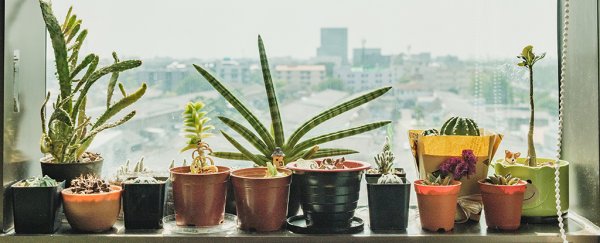Indoor air quality can be significantly improved by houseplants, new research has shown – specifically in terms of removing nitrogen dioxide (NO2) from the air, a pollutant created from fuel burning that's been linked to respiratory disease.
Potted plants are simple to install, affordable to buy, and potentially a genuinely effective option when it comes to reducing NO2 levels in homes and offices, the new study explains.
The common plants peace lily (Spathiphyllum wallisii), corn plant (Dracaena fragrans) and fern arum (Zamioculcas zamiifolia) were selected for testing, and in experiments, they reduced NO2 levels by as much as 20 percent in some scenarios.
"The plants we chose were all very different from each other, yet they all showed strikingly similar abilities to remove NO2 from the atmosphere," says chemist Christian Pfrang from the University of Birmingham in the UK.
For the purposes of the study, each plant was placed in a test chamber with around the same level of NO2 as you would expect in an office next to a busy road. Over the course of just an hour, all the plant species were able to remove about half of the NO2.
Extrapolating the result out to a small office (15 cubic meters or 530 cubic feet) with five plants in it, the researchers suggest about a 20 percent NO2 reduction should be possible in a poorly ventilated space.
Somewhere much larger, 100 cubic meters or around 3,500 cubic feet, would see a drop in the pollutant of just 3.5 percent, the researchers calculate – but then again, more plants could be added to make up for the additional room.
Importantly, this reduction was achieved in both dark and light conditions, and with both dry and wet soil. In previous studies looking at carbon dioxide (CO2) removal, these environmental conditions did influence how much the air quality was improved.
"We don't think the plants are using the same process as they do for CO2 uptake, in which the gas is absorbed through stomata – tiny holes – in the leaves," says Pfrang.
"There was no indication, even during longer experiments, that our plants released the NO2 back into the atmosphere, so there is likely a biological process taking place also involving the soil the plant grows in – but we don't yet know what that is."
Long-term ScienceAlert readers may remember a previous study that debunked the idea that household plants could improve indoor air quality – but that study looked at volatile organic compound (VOC) pollutants, rather than nitrogen dioxide levels.
Part of the difficulty in getting a definitive verdict on this is that real-world homes and offices don't necessarily work in the same way as lab experiments, with new air (and new pollutants) tending to flow in all the time. In this case, though, the researchers did run calculations for larger areas and different types of ventilation.
Future research is likely to look at the exact mechanisms that these plants are using to remove NO2 from the air, and how they compare to 'green walls' – entire walls of plant life that are likely to be even more effective at cleaning up air.
"Understanding the limits of what we can expect from plants helps us plan and advise on planting combinations that not only look good but also provide an important environmental service," says horticultural scientist Tijana Blanusa from the Royal Horticultural Society in the UK.
The research has been published in Air Quality, Atmosphere and Health.
